翻译理论知识修订稿
- 格式:docx
- 大小:103.55 KB
- 文档页数:63
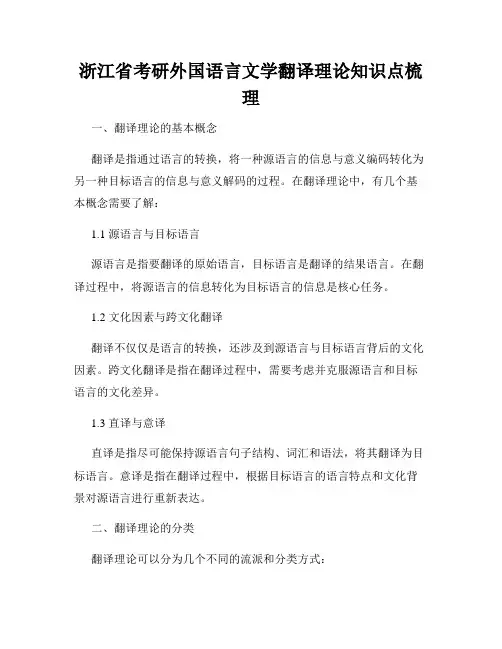
浙江省考研外国语言文学翻译理论知识点梳理一、翻译理论的基本概念翻译是指通过语言的转换,将一种源语言的信息与意义编码转化为另一种目标语言的信息与意义解码的过程。
在翻译理论中,有几个基本概念需要了解:1.1 源语言与目标语言源语言是指要翻译的原始语言,目标语言是翻译的结果语言。
在翻译过程中,将源语言的信息转化为目标语言的信息是核心任务。
1.2 文化因素与跨文化翻译翻译不仅仅是语言的转换,还涉及到源语言与目标语言背后的文化因素。
跨文化翻译是指在翻译过程中,需要考虑并克服源语言和目标语言的文化差异。
1.3 直译与意译直译是指尽可能保持源语言句子结构、词汇和语法,将其翻译为目标语言。
意译是指在翻译过程中,根据目标语言的语言特点和文化背景对源语言进行重新表达。
二、翻译理论的分类翻译理论可以分为几个不同的流派和分类方式:2.1 传统翻译理论传统翻译理论主要关注语言层面的转换,包括词汇、语法、句子结构等方面的处理。
代表性的理论有相当无理论、工科翻译理论等。
2.2 文化翻译理论文化翻译理论强调翻译过程中的文化因素,包括文化意象、价值观念、习惯用语等。
代表性的理论有劳德鲁普的文化翻译理论等。
2.3 功能翻译理论功能翻译理论关注翻译的目的和功能,包括传递信息、表达情感、文化交流等方面。
代表性的理论有新修订功能翻译理论等。
三、翻译理论的方法与技巧在翻译过程中,有一些常用的方法与技巧可以帮助提高翻译质量:3.1 目标语言优先原则目标语言优先原则是指在翻译过程中,优先考虑目标语言的表达习惯和规则,尽可能使翻译结果符合目标语言的语言习惯和文化背景。
3.2 多元化文本处理多元化文本处理是指在翻译过程中灵活运用不同的翻译策略和修辞手法,以达到更准确、流畅的翻译效果。
3.3 注意上下文语境上下文语境是翻译过程中必须关注的重要因素。
翻译时应仔细分析原文的上下文语境,确保翻译的准确性和连贯性。
四、翻译理论在实践中的应用翻译理论不仅仅是学术研究的范畴,也在实际翻译工作中起到指导和帮助作用:4.1 文学翻译文学翻译要求翻译者在保持原著意境的同时,注重目标语言的文化表达和美学效果。
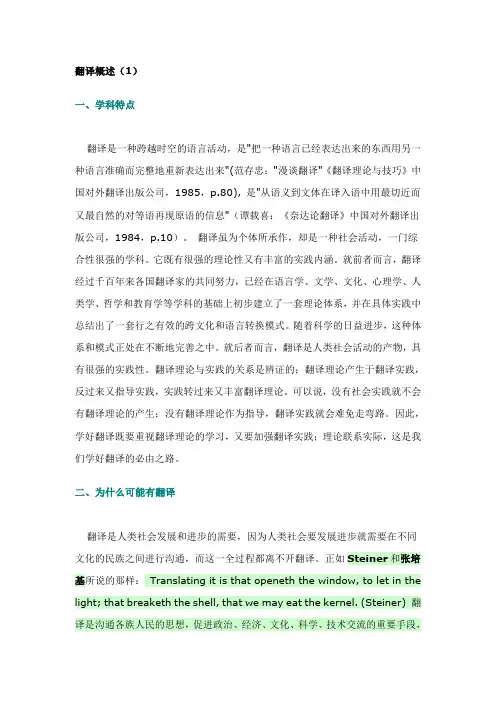
翻译概述(1)一、学科特点翻译是一种跨越时空的语言活动,是"把一种语言已经表达出来的东西用另一种语言准确而完整地重新表达出来"(范存忠:"漫谈翻译"《翻译理论与技巧》中国对外翻译出版公司,1985,p.80), 是"从语义到文体在译入语中用最切近而又最自然的对等语再现原语的信息"(谭载喜:《奈达论翻译》中国对外翻译出版公司,1984,p.10)。
翻译虽为个体所承作,却是一种社会活动,一门综合性很强的学科。
它既有很强的理论性又有丰富的实践内涵。
就前者而言,翻译经过千百年来各国翻译家的共同努力,已经在语言学、文学、文化、心理学、人类学、哲学和教育学等学科的基础上初步建立了一套理论体系,并在具体实践中总结出了一套行之有效的跨文化和语言转换模式。
随着科学的日益进步,这种体系和模式正处在不断地完善之中。
就后者而言,翻译是人类社会活动的产物,具有很强的实践性。
翻译理论与实践的关系是辨证的;翻译理论产生于翻译实践,反过来又指导实践,实践转过来又丰富翻译理论。
可以说,没有社会实践就不会有翻译理论的产生;没有翻译理论作为指导,翻译实践就会难免走弯路。
因此,学好翻译既要重视翻译理论的学习,又要加强翻译实践;理论联系实际,这是我们学好翻译的必由之路。
二、为什么可能有翻译翻译是人类社会发展和进步的需要,因为人类社会要发展进步就需要在不同文化的民族之间进行沟通,而这一全过程都离不开翻译。
正如Steiner和张培基所说的那样:Translating it is that openeth the window, to let in the light; that breaketh the shell, that we may eat the kernel. (Steiner) 翻译是沟通各族人民的思想,促进政治、经济、文化、科学、技术交流的重要手段,也是进行国际斗争的必要武器。
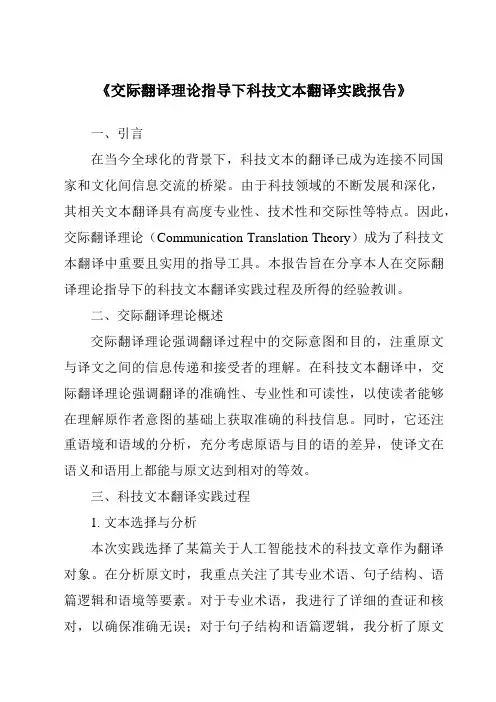
《交际翻译理论指导下科技文本翻译实践报告》一、引言在当今全球化的背景下,科技文本的翻译已成为连接不同国家和文化间信息交流的桥梁。
由于科技领域的不断发展和深化,其相关文本翻译具有高度专业性、技术性和交际性等特点。
因此,交际翻译理论(Communication Translation Theory)成为了科技文本翻译中重要且实用的指导工具。
本报告旨在分享本人在交际翻译理论指导下的科技文本翻译实践过程及所得的经验教训。
二、交际翻译理论概述交际翻译理论强调翻译过程中的交际意图和目的,注重原文与译文之间的信息传递和接受者的理解。
在科技文本翻译中,交际翻译理论强调翻译的准确性、专业性和可读性,以使读者能够在理解原作者意图的基础上获取准确的科技信息。
同时,它还注重语境和语域的分析,充分考虑原语与目的语的差异,使译文在语义和语用上都能与原文达到相对的等效。
三、科技文本翻译实践过程1. 文本选择与分析本次实践选择了某篇关于人工智能技术的科技文章作为翻译对象。
在分析原文时,我重点关注了其专业术语、句子结构、语篇逻辑和语境等要素。
对于专业术语,我进行了详细的查证和核对,以确保准确无误;对于句子结构和语篇逻辑,我分析了原文的表述方式,以便在译文中保持一致的逻辑关系;对于语境的分析,我考虑了目的语读者的文化背景和认知水平,以便进行适当的语言调整。
2. 翻译策略与方法在交际翻译理论的指导下,我采用了以下翻译策略与方法:(1)术语统一:对于专业术语,我建立了术语表,确保全文中术语的统一性。
(2)语义翻译与交际翻译相结合:在保证语义准确的前提下,我注重译文的流畅性和可读性,使读者能够更好地理解原文信息。
(3)语域与语境适应:根据目的语读者的语域和语境,我进行了适当的语言调整,以使译文更符合目的语的语言习惯。
(4)注重语篇分析:在翻译过程中,我关注原文的语篇逻辑关系,确保译文的连贯性和一致性。
3. 实践案例分析以原文中的一句为例:“人工智能技术能够通过学习人类行为模式,自动识别和适应不同的环境。
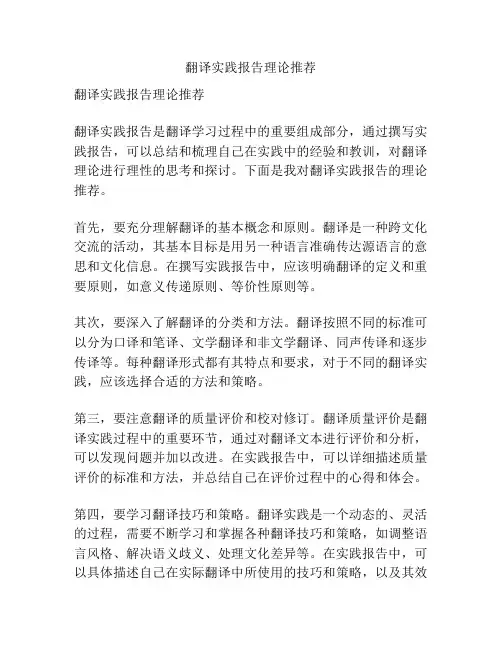
翻译实践报告理论推荐翻译实践报告理论推荐翻译实践报告是翻译学习过程中的重要组成部分,通过撰写实践报告,可以总结和梳理自己在实践中的经验和教训,对翻译理论进行理性的思考和探讨。
下面是我对翻译实践报告的理论推荐。
首先,要充分理解翻译的基本概念和原则。
翻译是一种跨文化交流的活动,其基本目标是用另一种语言准确传达源语言的意思和文化信息。
在撰写实践报告中,应该明确翻译的定义和重要原则,如意义传递原则、等价性原则等。
其次,要深入了解翻译的分类和方法。
翻译按照不同的标准可以分为口译和笔译、文学翻译和非文学翻译、同声传译和逐步传译等。
每种翻译形式都有其特点和要求,对于不同的翻译实践,应该选择合适的方法和策略。
第三,要注意翻译的质量评价和校对修订。
翻译质量评价是翻译实践过程中的重要环节,通过对翻译文本进行评价和分析,可以发现问题并加以改进。
在实践报告中,可以详细描述质量评价的标准和方法,并总结自己在评价过程中的心得和体会。
第四,要学习翻译技巧和策略。
翻译实践是一个动态的、灵活的过程,需要不断学习和掌握各种翻译技巧和策略,如调整语言风格、解决语义歧义、处理文化差异等。
在实践报告中,可以具体描述自己在实际翻译中所使用的技巧和策略,以及其效果和体会。
第五,要关注社会和技术发展对翻译的影响。
随着全球化进程的不断推进,翻译行业也面临着新的机遇和挑战。
新兴技术如机器翻译、计算机辅助翻译等对传统翻译模式和方法提出了新的要求。
在实践报告中,可以结合实际案例,探讨社会和技术发展对翻译的影响,提出自己的看法和建议。
总之,翻译实践报告是对翻译理论和实践的深入思考和总结,通过理论推荐可以更好地指导实践。
在撰写报告时,要结合自己的实际翻译经验,运用相关理论知识进行分析和论述,以提高自己的翻译能力和水平。
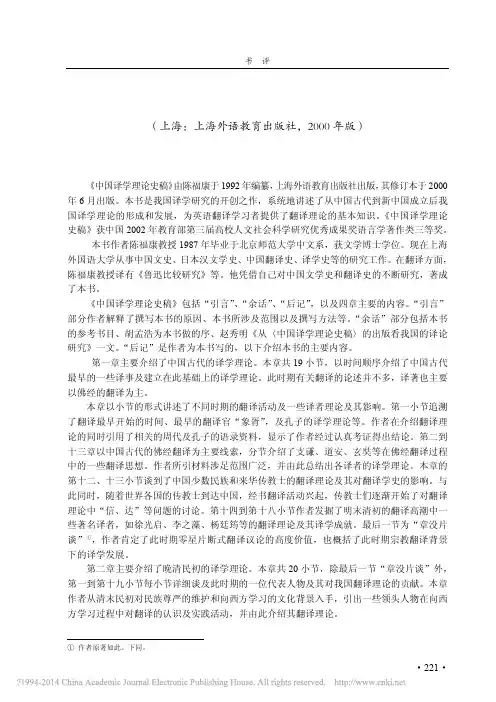
书 评陈福康:《中国译学理论史稿》(修订本)(上海:上海外语教育出版社,2000年版)《中国译学理论史稿》由陈福康于1992年编纂,上海外语教育出版社出版,其修订本于2000年6月出版。
本书是我国译学研究的开创之作,系统地讲述了从中国古代到新中国成立后我国译学理论的形成和发展,为英语翻译学习者提供了翻译理论的基本知识。
《中国译学理论史稿》获中国2002年教育部第三届高校人文社会科学研究优秀成果奖语言学著作类三等奖。
本书作者陈福康教授1987年毕业于北京师范大学中文系,获文学博士学位。
现在上海外国语大学从事中国文史、日本汉文学史、中国翻译史、译学史等的研究工作。
在翻译方面,陈福康教授译有《鲁迅比较研究》等。
他凭借自己对中国文学史和翻译史的不断研究,著成了本书。
《中国译学理论史稿》包括“引言”、“余话”、“后记”,以及四章主要的内容。
“引言”部分作者解释了撰写本书的原因、本书所涉及范围以及撰写方法等。
“余话”部分包括本书的参考书目、胡孟浩为本书做的序、赵秀明《从〈中国译学理论史稿〉的出版看我国的译论研究》一文。
“后记”是作者为本书写的,以下介绍本书的主要内容。
第一章主要介绍了中国古代的译学理论。
本章共19小节,以时间顺序介绍了中国古代最早的一些译事及建立在此基础上的译学理论。
此时期有关翻译的论述并不多,译著也主要以佛经的翻译为主。
本章以小节的形式讲述了不同时期的翻译活动及一些译者理论及其影响。
第一小节追溯了翻译最早开始的时间、最早的翻译官“象胥”,及孔子的译学理论等。
作者在介绍翻译理论的同时引用了相关的周代及孔子的语录资料,显示了作者经过认真考证得出结论。
第二到十三章以中国古代的佛经翻译为主要线索,分节介绍了支谦、道安、玄奘等在佛经翻译过程中的一些翻译思想。
作者所引材料涉足范围广泛,并由此总结出各译者的译学理论。
本章的第十二、十三小节谈到了中国少数民族和来华传教士的翻译理论及其对翻译学史的影响。
与此同时,随着世界各国的传教士到达中国,经书翻译活动兴起,传教士们逐渐开始了对翻译理论中“信、达”等问题的讨论。
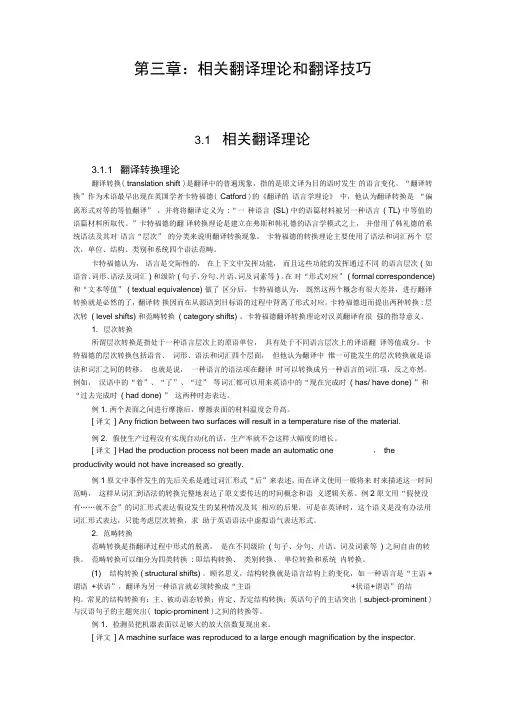
第三章:相关翻译理论和翻译技巧3.1 相关翻译理论3.1.1 翻译转换理论翻译转换( translation shift )是翻译中的普遍现象,指的是原文译为目的语时发生的语言变化。
“翻译转换”作为术语最早出现在英国学者卡特福德( Catford )的《翻译的语言学理论》中,他认为翻译转换是“偏离形式对等的等值翻译” ,并将将翻译定义为:“一种语言(SL) 中的语篇材料被另一种语言( TL) 中等值的语篇材料所取代。
”卡特福德的翻译转换理论是建立在弗斯和韩礼德的语言学模式之上,并借用了韩礼德的系统语法及其对语言“层次” 的分类来说明翻译转换现象。
卡特福德的转换理论主要使用了语法和词汇两个层次,单位、结构、类别和系统四个语法范畴。
卡特福德认为,语言是交际性的,在上下文中发挥功能,而且这些功能的发挥通过不同的语言层次( 如语音、词形、语法及词汇) 和级阶( 句子、分句、片语、词及词素等) 。
在对“形式对应” ( formal correspondence) 和“文本等值” ( textual equivalence) 做了区分后,卡特福德认为,既然这两个概念有很大差异,进行翻译转换就是必然的了,翻译转换因而在从源语到目标语的过程中背离了形式对应。
卡特福德进而提出两种转换: 层次转( level shifts) 和范畴转换( category shifts) 。
卡特福德翻译转换理论对汉英翻译有很强的指导意义。
1. 层次转换所谓层次转换是指处于一种语言层次上的原语单位,具有处于不同语言层次上的译语翻译等值成分。
卡特福德的层次转换包括语音、词形、语法和词汇四个层面,但他认为翻译中惟一可能发生的层次转换就是语法和词汇之间的转移。
也就是说,一种语言的语法项在翻译时可以转换成另一种语言的词汇项,反之亦然。
例如,汉语中的“着”、“了”、“过” 等词汇都可以用来英语中的“现在完成时( has/ have done) ”和“过去完成时( had done) ” 这两种时态表达。
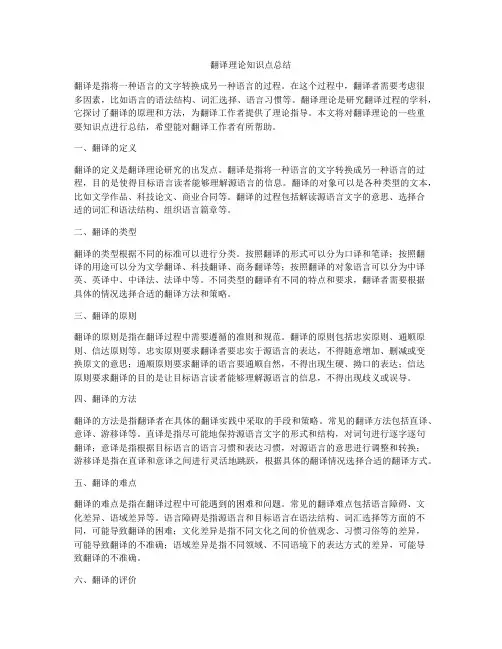
翻译理论知识点总结翻译是指将一种语言的文字转换成另一种语言的过程。
在这个过程中,翻译者需要考虑很多因素,比如语言的语法结构、词汇选择、语言习惯等。
翻译理论是研究翻译过程的学科,它探讨了翻译的原理和方法,为翻译工作者提供了理论指导。
本文将对翻译理论的一些重要知识点进行总结,希望能对翻译工作者有所帮助。
一、翻译的定义翻译的定义是翻译理论研究的出发点。
翻译是指将一种语言的文字转换成另一种语言的过程,目的是使得目标语言读者能够理解源语言的信息。
翻译的对象可以是各种类型的文本,比如文学作品、科技论文、商业合同等。
翻译的过程包括解读源语言文字的意思、选择合适的词汇和语法结构、组织语言篇章等。
二、翻译的类型翻译的类型根据不同的标准可以进行分类。
按照翻译的形式可以分为口译和笔译;按照翻译的用途可以分为文学翻译、科技翻译、商务翻译等;按照翻译的对象语言可以分为中译英、英译中、中译法、法译中等。
不同类型的翻译有不同的特点和要求,翻译者需要根据具体的情况选择合适的翻译方法和策略。
三、翻译的原则翻译的原则是指在翻译过程中需要遵循的准则和规范。
翻译的原则包括忠实原则、通顺原则、信达原则等。
忠实原则要求翻译者要忠实于源语言的表达,不得随意增加、删减或变换原文的意思;通顺原则要求翻译的语言要通顺自然,不得出现生硬、拗口的表达;信达原则要求翻译的目的是让目标语言读者能够理解源语言的信息,不得出现歧义或误导。
四、翻译的方法翻译的方法是指翻译者在具体的翻译实践中采取的手段和策略。
常见的翻译方法包括直译、意译、游移译等。
直译是指尽可能地保持源语言文字的形式和结构,对词句进行逐字逐句翻译;意译是指根据目标语言的语言习惯和表达习惯,对源语言的意思进行调整和转换;游移译是指在直译和意译之间进行灵活地跳跃,根据具体的翻译情况选择合适的翻译方式。
五、翻译的难点翻译的难点是指在翻译过程中可能遇到的困难和问题。
常见的翻译难点包括语言障碍、文化差异、语域差异等。
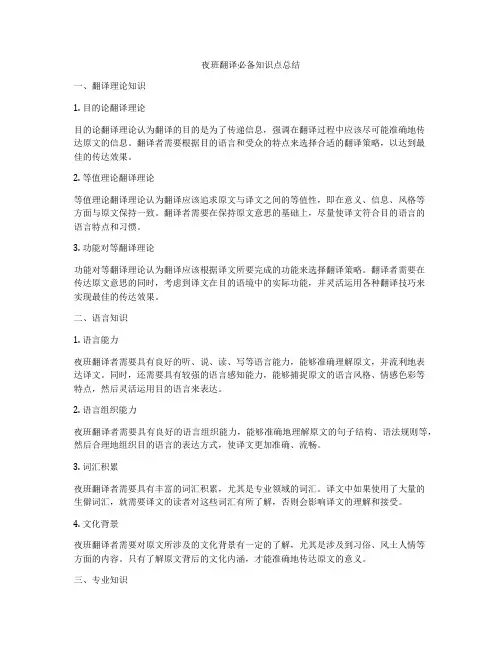
夜班翻译必备知识点总结一、翻译理论知识1. 目的论翻译理论目的论翻译理论认为翻译的目的是为了传递信息,强调在翻译过程中应该尽可能准确地传达原文的信息。
翻译者需要根据目的语言和受众的特点来选择合适的翻译策略,以达到最佳的传达效果。
2. 等值理论翻译理论等值理论翻译理论认为翻译应该追求原文与译文之间的等值性,即在意义、信息、风格等方面与原文保持一致。
翻译者需要在保持原文意思的基础上,尽量使译文符合目的语言的语言特点和习惯。
3. 功能对等翻译理论功能对等翻译理论认为翻译应该根据译文所要完成的功能来选择翻译策略。
翻译者需要在传达原文意思的同时,考虑到译文在目的语境中的实际功能,并灵活运用各种翻译技巧来实现最佳的传达效果。
二、语言知识1. 语言能力夜班翻译者需要具有良好的听、说、读、写等语言能力,能够准确理解原文,并流利地表达译文。
同时,还需要具有较强的语言感知能力,能够捕捉原文的语言风格、情感色彩等特点,然后灵活运用目的语言来表达。
2. 语言组织能力夜班翻译者需要具有良好的语言组织能力,能够准确地理解原文的句子结构、语法规则等,然后合理地组织目的语言的表达方式,使译文更加准确、流畅。
3. 词汇积累夜班翻译者需要具有丰富的词汇积累,尤其是专业领域的词汇。
译文中如果使用了大量的生僻词汇,就需要译文的读者对这些词汇有所了解,否则会影响译文的理解和接受。
4. 文化背景夜班翻译者需要对原文所涉及的文化背景有一定的了解,尤其是涉及到习俗、风土人情等方面的内容。
只有了解原文背后的文化内涵,才能准确地传达原文的意义。
三、专业知识1. 行业专业知识夜班翻译者需要对自己所翻译的内容有一定的了解,尤其是涉及到行业专业知识的内容。
只有对行业有一定的了解,才能更好地理解原文并准确地表达译文,从而满足受众的需求。
2. 熟悉常见术语夜班翻译者需要熟悉常见的领域术语,尤其是涉及到专业领域的翻译。
只有对专业术语有一定的了解,才能准确地理解原文,并用目的语言合理地表达。
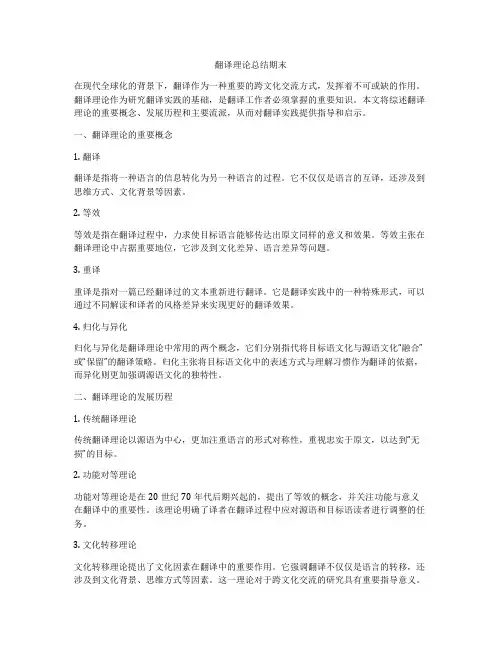
翻译理论总结期末在现代全球化的背景下,翻译作为一种重要的跨文化交流方式,发挥着不可或缺的作用。
翻译理论作为研究翻译实践的基础,是翻译工作者必须掌握的重要知识。
本文将综述翻译理论的重要概念、发展历程和主要流派,从而对翻译实践提供指导和启示。
一、翻译理论的重要概念1. 翻译翻译是指将一种语言的信息转化为另一种语言的过程。
它不仅仅是语言的互译,还涉及到思维方式、文化背景等因素。
2. 等效等效是指在翻译过程中,力求使目标语言能够传达出原文同样的意义和效果。
等效主张在翻译理论中占据重要地位,它涉及到文化差异、语言差异等问题。
3. 重译重译是指对一篇已经翻译过的文本重新进行翻译。
它是翻译实践中的一种特殊形式,可以通过不同解读和译者的风格差异来实现更好的翻译效果。
4. 归化与异化归化与异化是翻译理论中常用的两个概念,它们分别指代将目标语文化与源语文化“融合”或“保留”的翻译策略。
归化主张将目标语文化中的表述方式与理解习惯作为翻译的依据,而异化则更加强调源语文化的独特性。
二、翻译理论的发展历程1. 传统翻译理论传统翻译理论以源语为中心,更加注重语言的形式对称性,重视忠实于原文,以达到“无损”的目标。
2. 功能对等理论功能对等理论是在20世纪70年代后期兴起的,提出了等效的概念,并关注功能与意义在翻译中的重要性。
该理论明确了译者在翻译过程中应对源语和目标语读者进行调整的任务。
3. 文化转移理论文化转移理论提出了文化因素在翻译中的重要作用。
它强调翻译不仅仅是语言的转移,还涉及到文化背景、思维方式等因素。
这一理论对于跨文化交流的研究具有重要指导意义。
4. 重译和再翻译理论重译和再翻译理论强调翻译是一个不断发展的过程,通过对已有翻译作品的再审视和重新翻译,可以实现更好的翻译效果。
这一理论提醒翻译者不仅要注重翻译策略,还要不断提升自己的翻译水平。
三、翻译理论的主要流派1. 源语导向理论源语导向理论以源语为中心,强调翻译要忠实于原文,力求实现“无损”翻译。
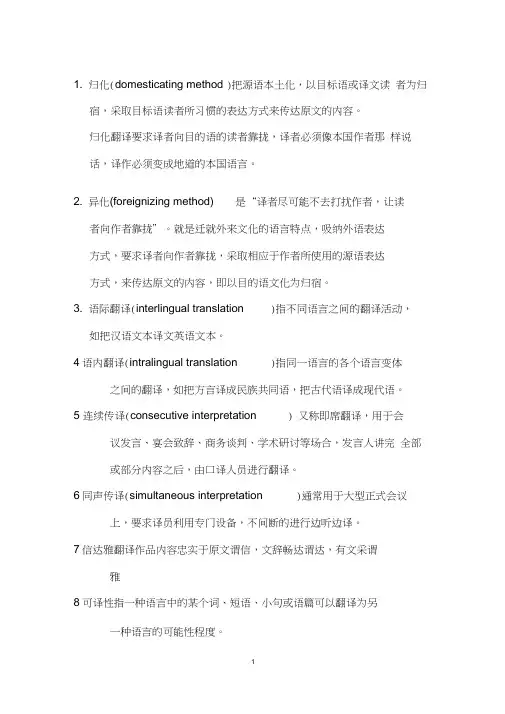
1. 归化(domesticating method )把源语本土化,以目标语或译文读者为归宿,采取目标语读者所习惯的表达方式来传达原文的内容。
归化翻译要求译者向目的语的读者靠拢,译者必须像本国作者那样说话,译作必须变成地道的本国语言。
2. 异化(foreignizing method) 是“译者尽可能不去打扰作者,让读者向作者靠拢”。
就是迁就外来文化的语言特点,吸纳外语表达方式,要求译者向作者靠拢,采取相应于作者所使用的源语表达方式,来传达原文的内容,即以目的语文化为归宿。
3. 语际翻译(interlingual translation )指不同语言之间的翻译活动,如把汉语文本译文英语文本。
4语内翻译(intralingual translation )指同一语言的各个语言变体之间的翻译,如把方言译成民族共同语,把古代语译成现代语。
5 连续传译(consecutive interpretation ) 又称即席翻译,用于会议发言、宴会致辞、商务谈判、学术研讨等场合,发言人讲完全部或部分内容之后,由口译人员进行翻译。
6同声传译(simultaneous interpretation )通常用于大型正式会议上,要求译员利用专门设备,不间断的进行边听边译。
7信达雅翻译作品内容忠实于原文谓信,文辞畅达谓达,有文采谓雅8可译性指一种语言中的某个词、短语、小句或语篇可以翻译为另一种语言的可能性程度。
9.形合( hypotaxis )指句中的词语或分句之间需要一种语言形式手段(如连词或关联词)连接起来,表达一定的语法意义和逻辑关系。
10. 意合(parataxis) 之词语或分句之间不用语言形式手段进行连接,句中的语法意义和逻辑关系通过词语或分句的含义来表达。
11 直译( literal translation )即直接翻译,指译文基本上按原文的形式和结构进行翻译,但也并非是死扣原文,字字翻译12 意译 (free translation ) 不拘泥于原文的语言形式和结构,按译文的习惯将原文意义表达出来。
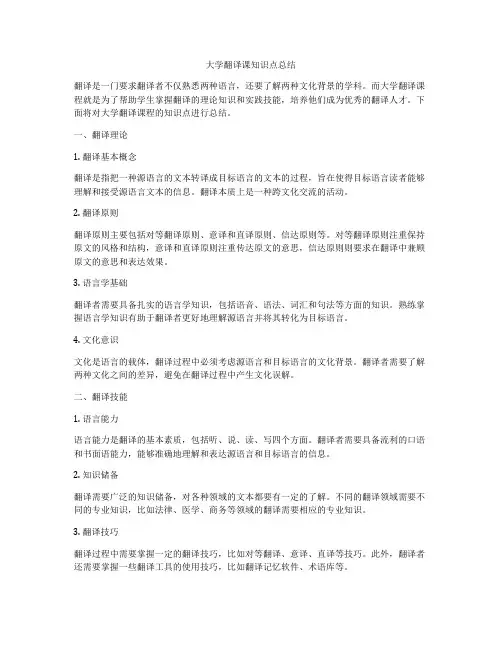
大学翻译课知识点总结翻译是一门要求翻译者不仅熟悉两种语言,还要了解两种文化背景的学科。
而大学翻译课程就是为了帮助学生掌握翻译的理论知识和实践技能,培养他们成为优秀的翻译人才。
下面将对大学翻译课程的知识点进行总结。
一、翻译理论1. 翻译基本概念翻译是指把一种源语言的文本转译成目标语言的文本的过程,旨在使得目标语言读者能够理解和接受源语言文本的信息。
翻译本质上是一种跨文化交流的活动。
2. 翻译原则翻译原则主要包括对等翻译原则、意译和直译原则、信达原则等。
对等翻译原则注重保持原文的风格和结构,意译和直译原则注重传达原文的意思,信达原则则要求在翻译中兼顾原文的意思和表达效果。
3. 语言学基础翻译者需要具备扎实的语言学知识,包括语音、语法、词汇和句法等方面的知识。
熟练掌握语言学知识有助于翻译者更好地理解源语言并将其转化为目标语言。
4. 文化意识文化是语言的载体,翻译过程中必须考虑源语言和目标语言的文化背景。
翻译者需要了解两种文化之间的差异,避免在翻译过程中产生文化误解。
二、翻译技能1. 语言能力语言能力是翻译的基本素质,包括听、说、读、写四个方面。
翻译者需要具备流利的口语和书面语能力,能够准确地理解和表达源语言和目标语言的信息。
2. 知识储备翻译需要广泛的知识储备,对各种领域的文本都要有一定的了解。
不同的翻译领域需要不同的专业知识,比如法律、医学、商务等领域的翻译需要相应的专业知识。
3. 翻译技巧翻译过程中需要掌握一定的翻译技巧,比如对等翻译、意译、直译等技巧。
此外,翻译者还需要掌握一些翻译工具的使用技巧,比如翻译记忆软件、术语库等。
4. 翻译实践翻译实践是提高翻译水平的重要手段,通过大量翻译练习可以提高翻译速度和准确度,培养翻译者的审美能力和创造力。
三、翻译方法1. 直译直译是指尽量保持源语言的结构和风格,只在必要的情况下做出一些改动。
直译的特点是忠实于原文,同时在保持原文意思的基础上作出必要的修饰。
2. 意译意译是指在翻译过程中放弃源语言的词句,而用目标语言的词句表达相同的意义。
《翻译理论与实践》考试理论部分复习提纲一、翻译定义:1. 张培基——翻译是用一种语言把另一种语言所表达的思维内容准确而完整地重新表达出来的语言活动。
?3. 刘宓庆——翻译的实质是语际的意义转换。
?4. 王克非——翻译是将一种语言文字所蕴含的意思用另一种语言文字表达出来的文化活动。
5. 泰特勒——好的翻译应该是把原作的长处完全地移注到另一种语言,以使译入语所属国家的本地人能明白地领悟、强烈地感受,如同使用原作语言的人所领悟、所感受的一样。
?6. 费道罗夫——翻译就是用一种语言把另一种语言在内容与形式不可分割的统一中所有已表达出来的东西准确而完全地表达出来。
?7. 卡特福德——翻译的定义也可以这样说:把一种语言(Source Language)中的篇章材料用另一种语言(Target Language)中的篇章材料来加以代替。
8.奈达——翻译就是在译入语中再现与原语信息最切近的自然对等物,首先就意义而言,其次就是文体而言。
“Translating consists in reproducing in the receptor language the closest natural equivalent of the source language message, first in terms of meaning and secondly in terms of style.”---Eugene Nida纽马克——通常(虽然不能说总是如此),翻译就是把一个文本的意义按作者所想的方式移译入另一种文字(语言)。
“Translation is a craft consisting in the attempt to replace a written message and/or statement in one language by the same message and/or statement in another language.”--- Peter Newmark10. “Translation is the expression in one language (or target language译入语) of what has been expressed in another language (source language 原语), preserving semantic and stylistic equivalences.”--- Dubois12. 13.Translation or translating is a communicative activity or dynamic process in which the translator makes great effort to thoroughly comprehend a written message or text in the source language and works very hard to achieve an adequate or an almost identical reproduction in the target language version of the written source language message or text.二、翻译标准1. 翻译的标准概括为言简意赅的四个字:“忠实(faithfulness)、通顺(smoothness)”。
文言文翻译原则方法技巧讲解Document number【SA80SAB-SAA9SYT-SAATC-SA6UT-SA18】一.文言文翻译原则、方法、技巧教学目标:让学生掌握文言文翻译的基本原则。
教学难点:让学生掌握文言文翻译的方法与技巧。
教学时数:贯穿于文言文教学的全过程。
一文言文直译的原则——信、达、雅“信”是忠实于原文的内容和每个句子的含义。
“达”就是翻译出的现代文表意要明确,语言要通畅。
“雅”就是用简明、优美、富有文采的现代汉语把原文的内容、形式以及风格准确表达出来。
注释:“信”,就是译文要准确表达原文的意思,不歪曲、不遗漏、不增译。
“达”,就是译文明白晓畅,符合现代汉语表达要求和习惯,无语病。
“雅”,就是译文语句规范、得体、生动、优美。
注意:字字落实,直译为主,意译为辅。
直译,指译文要与原文保持对应关系,重要的词语要相应的落实,要尽力保持原文遣词造句的特点和相近的表达方式,力求语言风格也和原文一致。
意译,指着眼于表达原句的意思,在忠于原意的前提下,灵活翻译原文的词语,灵活处理原文的句子结构。
两者的关系是,只有在直译表达不了原文意旨的情况下,才在相关部分辅之以意译。
二文言直译的方法——“九字法”(一)针对实词(1) 留。
专有名词、国号、年号、人名、物名、地名、职称、器具等,可照录不翻译,例如:a 既而以吴民之乱请于朝,按诛五人,日颜佩韦、杨念如、马杰、沈杨、周文元,即今之傫然在墓者也。
b 余以乾隆三十九年十二月,自京师乘风雪,历齐河、长清,穿泰山西北谷,越长城之限,至于泰安。
c 江宁之龙皤,苏州之邓尉,杭州之西溪,皆产梅。
d 褒禅山亦谓之华山。
(2) 译。
译出偏义复词、古今异义词、活用现象和通假字等文言现象。
a 先是,庭中通南北为一。
b 吾社之行为士先者,为之声义,敛赀财以送其行。
c 以旌其所为d 至莫夜月明,独与迈乘小舟,至绝壁下。
(3) 意。
文言文中的比喻、借代、引申等意义,直译会不明确,应用意译,例如:a 大阉之乱,缙绅而能不易其志者,四海之大,有几人欤b 况草野之无闻者欤c 借书满架,偃仰啸歌,冥然兀坐,万籁有声。
(完整版)中西翻译理论整理汇总翻译理论整理汇总翻译腔(translationeses)是在译文中留有源语言特征等翻译痕迹的现象,严重的翻译腔使译文读起来不够通顺。
出现翻译腔有时是很难免的。
形成翻译腔有以下几个原因:1)英汉语言本身的不同,包括句型结构等,在翻译时如果不能做到自由转换就会有种不是地道目标语的感觉。
2)英汉文化的不同,不同的文化背景下,单词或习语有时会出现偏差甚至零对等(zero-correspondence)。
有时只讲词对词的反应就会出现翻译腔。
3)译者自身水平。
奈达的功能对等就要求译者注重译文对读者的影响,好的译文让读者感觉是母语的写作、实现功能的对等。
Venuti主张同化和异化的结合,通过同化让读者获得相识的反应,通过异化使读者领略异国语言和文化。
译者应该提高自己翻译水平,在翻译策略上实现功能对等,从而尽量避免翻译腔的出现。
1. 中国的翻译理论家严复、茅盾、鲁迅、朱光潜、傅雷、钱钟书1)严复信、达、雅——faithfulness、expressiveness、elegance/gracefulness2)茅盾他也主张“直译”,反对“意译”,他认为汉语确实存在语言组织上欠严密的不足,有必要吸引印欧语系的句法形态。
但是矛盾与鲁迅观点同中有异,他认为“直译”并不是“字对字”,一个不多,一个不少。
因为中西文法结构截然不同,纯粹的“字对字”是不可能的。
3)鲁迅鲁迅的“宁信而不顺”是“凡是翻译,必须兼顾两面,一当然是力求易解,一则保存着原作风姿”,这是鲁迅的基本思想。
针对当年那种“牛头不对马嘴”的胡译、乱译以及所谓“与其信而不顺,不如顺而不信”的说法(梁秋实),提出了“宁信而不顺”这一原则,主张直译,以照顾输入新表现法和保持原作的风貌。
他还认为,翻译一要“移情”、“益志”,译文要有“异国情调”,二要“输入新的表现法”,以改进中文的文法,在当时主要表现为改进白话文。
必须强调的是,鲁迅其实是主张翻译要通顺,又要忠实的。
翻译概述(1)一、学科特点翻译是一种跨越时空的语言活动,是"把一种语言已经表达出来的东西用另一种语言准确而完整地重新表达出来"(范存忠:"漫谈翻译"《翻译理论与技巧》中国对外翻译出版公司,1985,p.80), 是"从语义到文体在译入语中用最切近而又最自然的对等语再现原语的信息"(谭载喜:《奈达论翻译》中国对外翻译出版公司,1984,p.10)。
翻译虽为个体所承作,却是一种社会活动,一门综合性很强的学科。
它既有很强的理论性又有丰富的实践内涵。
就前者而言,翻译经过千百年来各国翻译家的共同努力,已经在语言学、文学、文化、心理学、人类学、哲学和教育学等学科的基础上初步建立了一套理论体系,并在具体实践中总结出了一套行之有效的跨文化和语言转换模式。
随着科学的日益进步,这种体系和模式正处在不断地完善之中。
就后者而言,翻译是人类社会活动的产物,具有很强的实践性。
翻译理论与实践的关系是辨证的;翻译理论产生于翻译实践,反过来又指导实践,实践转过来又丰富翻译理论。
可以说,没有社会实践就不会有翻译理论的产生;没有翻译理论作为指导,翻译实践就会难免走弯路。
因此,学好翻译既要重视翻译理论的学习,又要加强翻译实践;理论联系实际,这是我们学好翻译的必由之路。
二、为什么可能有翻译翻译是人类社会发展和进步的需要,因为人类社会要发展进步就需要在不同文化的民族之间进行沟通,而这一全过程都离不开翻译。
正如Steiner和张培基所说的那样:Translating it is that openeth the window, to let in the light; that breaketh the shell, that we may eat the kernel. (Steiner) 翻译是沟通各族人民的思想,促进政治、经济、文化、科学、技术交流的重要手段,也是进行国际斗争的必要武器。
翻译理论知识内部编号:(YUUT-TBBY-MMUT-URRUY-UOOY-DBUYI-0128)《翻译理论与实践》考试理论部分复习提纲一、翻译定义:1. 张培基——翻译是用一种语言把另一种语言所表达的思维内容准确而完整地重新表达出来的语言活动。
3. 刘宓庆——翻译的实质是语际的意义转换。
4. 王克非——翻译是将一种语言文字所蕴含的意思用另一种语言文字表达出来的文化活动。
5. 泰特勒——好的翻译应该是把原作的长处完全地移注到另一种语言,以使译入语所属国家的本地人能明白地领悟、强烈地感受,如同使用原作语言的人所领悟、所感受的一样。
6. 费道罗夫——翻译就是用一种语言把另一种语言在内容与形式不可分割的统一中所有已表达出来的东西准确而完全地表达出来。
7. 卡特福德——翻译的定义也可以这样说:把一种语言(Source Language)中的篇章材料用另一种语言(Target Language)中的篇章材料来加以代替。
8.奈达——翻译就是在译入语中再现与原语信息最切近的自然对等物,首先就意义而言,其次就是文体而言。
“Translating consists in reproducing in the receptor language the closest natural equivalent of the source language message, first in terms of meaning and secondly in terms of style.” ---Eugene Nida纽马克——通常(虽然不能说总是如此),翻译就是把一个文本的意义按作者所想的方式移译入另一种文字(语言)。
“Translation is a craft consisting in the attempt to replace a written message and/or statement in one language by the same message and/or statement in another language.” --- Peter Newmark10. “Translation is the expression in one language (or target language译入语) of what has been expressed in another language (source language 原语), preserving semantic and stylistic equivalences.” --- Dubois12. 13.Translation or translating is a communicative activity or dynamic process in which the translator makes great effort to thoroughly comprehend a written message or text in the source language and works very hard to achieve an adequate or an almost identical reproduction in the target language version of the written source language message or text.二、翻译标准1. 翻译的标准概括为言简意赅的四个字:“忠实(faithfulness)、通顺(smoothness)”。
忠实指的是忠实于原文。
通顺指的是译文的语言必须合乎规范、通俗易懂。
2. 严复对翻译曾经提出“信(faithfulness)、达(expressiveness)、雅(elegance)”的标准:“译事三难:信、达、雅。
求其信已大难矣,顾信矣不达,虽译犹不译也,则达尚焉。
”3.“泰特勒三原则”:(1)That the Translation should give a complete transcript of the ideas of the original work;(2)That the style and manner of writing should be of the same character with that of the original;(3)That the Translation should have all the ease of original composition.”(1)译作应完全复写出原作的思想;(2)译作的风格和手法应和原作属于同一性质;(3)译作应具备原作所具有的通顺。
”(谭载喜,2006)泰特勒指出,这三项原则是好的翻译所必备的条件,它们次序的排列是恰当的、自然的,是按重要顺序排列的,如果在不得已的情况下要牺牲某一个原则就要注意到它们的次第和比较上的重要性,决不能颠倒主次,以牺牲思想内容的忠实来求得译文的优美和流畅。
5. 奈达提出了着名的“动态对等”。
他对翻译所下的定义: 所谓翻译, 是在译语中用最切近而又最自然的对等语再现源语的信息, 首先是意义, 其次是文体。
Translating consists in reproducing in the receptor language the closest natural equivalent of the source-language message, first in terms of meaning and secondly in terms of style. (Nida &Taber,1969:12).这一定义明确指出翻译的本质和任务是用译语再现源语信息, 翻译的方法用最切近而又最自然的对等语。
6. 纽马克“文本中心”论:纽马克把要翻译的对象看成文本,并根据语言的功能把文本分为表达型、信息型和召唤型三大类。
表达型包括严肃的文学作品、声明和信件等;信息型包括书籍、报告、论文、备忘录等;召唤型包括各种宣传品、说明书和通俗小说等。
他认为不同的文本应该用不同的翻译方法(纽马克把翻译方法分为语义翻译和交际翻译两种。
前者强调忠实于原作“原作者”;后者强调忠实于译作“读者”),不同的评价标准,不同的“等效”要求。
8. 其他翻译标准?刘重德:信达切许渊冲:信达优;美化之艺术,创优似竞赛;(三美论:意美、音美、形美;等化、深化、浅化;知之、好之、乐之;发挥译入语优势)傅雷:重神似不重形似钱钟书:化境鲁迅:凡是翻译,必须兼顾两面:一则当然力求其易解,一则保存着原作的丰姿。
林语堂:音美、意美、神美、气美、形美郭沫若:好的翻译等于创作三、翻译过程理解和表达是翻译的两个主要步骤。
译者对原文的正确理解在翻译过程中至关重要;译者的表达须具有准确力和表现力,语言须具有生动性和形式美。
分析原文就是细致处理词位的所指意义和联想意义、研究句法和语篇结构。
理解和领会原文是从事无论何种翻译的基本功力。
如果译者确实理解了原文的涵义,又能得心应手地驾驭译语,那么翻译就是一个很自然的驾轻就熟的过程。
翻译的过程可以简单分为:理解—表达---校核三个阶段,或理解---表达两个阶段。
四、翻译分类:2. 从涉及到的符号来看,翻译可分为语内翻译(intralingual translation)(通过同一语言中的一些语言符号解释另一些符号,如把古汉语译成现代汉语),语际翻译(interlingual translation)(通过一种语言符号解释另一种语言符号,如把英语译成汉语),符际翻译(intersemiotic translation)(通过非语言的符号系统解释语言符号或用语言符号解释非语言符号,如用手势语解释一则新闻。
)3. 从翻译的手段来看,翻译可分为口译、笔译和机器翻译。
4.从翻译的题材来看明,翻译可分为专业性翻译(翻译法律、科技文献、专业学术论着等)、文学翻译(翻译小说、诗歌、戏剧等文学作品)和一般性翻译(翻译各种应用文和新闻报道等)。
5. 从翻译方式上来看,翻译可分为全译、摘译和编译。
泰特勒(Tytler,1748-1814)的翻译理论和思想主要见于《论翻译的原则》一书。
该书是西方翻译理论的第一部专着,在书中,泰特勒提出了着名的翻译三原则:1、译文应完整地再现原文的思想内容(That the translation should give a complete transcript of the ideas of the original work.); 2、译文的风格、笔调应与原文的性质相同(That the style and manner of writing should be of the same character with that of the original.);3、译文影响原文一样流畅(That the translation should have all the ease of the original composition.)。
八、常用翻译方法、策略与技巧1. 直译与意译(Literal translation and Free translation)英语与汉语的语言结构与文体结构有相同的一面,汉译时可照译,即所谓“直译”——既忠实原文内容,又符合原文的语言与文体结构。
由于人们在感情,在对客观事物的感受及社会经历等方面会有相似之处,英汉语言表达中有少量相同或近似的表达方式,这些表达方式的字面意义,形象意义相同或近似,隐含意义相同,也就是说,这些表达方式的字面意义和形象意义所传达出的文化信息是相同的,可以互译。
“意译”则从意义出发,只要求将原文大意表达出来,不需过分注重细节,但要求译文自然流畅。
由于文化因素的影响,在翻译时无法保留原语的字面意义和形象意义,可将原文的形象更换成另一个译文读者所熟悉的形象,从而转达出原文的语用目的,译出隐含意义。
英汉两种语言不同的发展历史,民族文化,风俗习惯造成了两个民族独特的语言与独特的表达方式。
因此,翻译时必须对两种语言文化基础有基本的认识,不能逐字翻译。
凡语言都有习惯表达,言外之意。
在深入领会原作的精神实质的前提之下,不拘泥于原作的字面形式,创造性的表达原作思想,但不可添枝加叶,改变原作的风格。
注:在翻译界通用的方法是将“直译”与“意译”相互结合。
任何一篇好的翻译作品,并不是单纯的某一种翻译方法贯穿始终,而是在保持原文内容的准确性,不引起歧义的情况下,将这两种翻译方法在同一翻译作品中并用,相得益彰。
笔者对翻译界的这种做法完全认同。